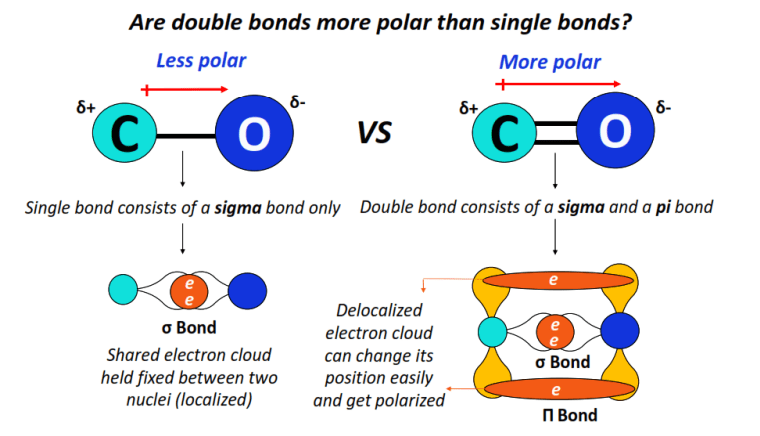Are double bonds more polar than single bonds?
The question is –
Are double bonds more polar than single bonds?
Answer:
⇒ Yes, double bonds formed between two dissimilar atoms are generally more polar than single covalent bonds.
Explanation:
A double bond formed between two dissimilar atoms, such as C=O, is more polar than a corresponding single covalent bond, such as C-O, because double bonds containing pi-bonded electrons are generally less strongly held and consequently easily polarizable.
As per Pauling’s electronegativity scale, a polar covalent bond is formed between two dissimilar atoms (X-Y) having an electronegativity difference between 0.4 to 1.6 units.
The more electronegative atom (Y) strongly attracts the X-Y shared electron cloud towards itself, gaining a partial negative charge (Yδ–). The other atom gains a partial positive charge (Xδ+), respectively.
An X-Y single covalent bond consists of a sigma (σ) bond only, while the X=Y double bond comprises a sigma and a pi (𝛑 ) bond.
The sigma-bonded electrons are strongly held and localized in the internuclear region.
Contrarily, pi-bonded electrons are comparatively weakly held above and below the two nuclei involved.
A pi-bond is thus easier to disturb and break as opposed to a sigma bond.
Delocalized electrons lead to an overall unequal charge distribution between the two participating atoms.
Therefore, in the presence of pi-bonded electrons (in a double bond such as C=O), there is a greater chance of developing oppositely charged poles in a molecule (i.e., it possesses greater polarizability).
Higher polarizability leads to greater dipole moment values; hence a C=O double bond is more polar than a C-O single bond.

You may note that this concept does not apply to bonds containing identical atoms.
For instance, a C=C double bond is not more polar than a C-C single bond.
This is because zero or no electronegativity difference exists between two carbon atoms; thus, no dipole moment value consequently, both C=C and C-C bonds are purely non-polar.
Also, check –
⇒ How to identify polar or nonpolar compounds?
Related Posts
- Is CH3CH2CH2OH polar or nonpolar? – Chemistry QnA
- Is OH2 polar or nonpolar? – Chemistry QnA
- Is ICl4- polar or nonpolar? – Chemistry QnA
- Is OH- polar or nonpolar? – Chemistry QnA
- Is SiS2 polar or nonpolar? – Chemistry QnA
- Is MgCl2 polar or nonpolar? – Chemistry QnA
- Is food coloring polar or nonpolar? – Chemistry QnA
- Is CaCl2 polar or nonpolar? – Chemistry QnA
- Is 2-propanol polar or nonpolar? – Chemistry QnA
- Is Octane (C8H18) polar or nonpolar? – Chemistry QnA
- Is S8 polar or nonpolar? – Chemistry QnA
- Is HCO3- polar or nonpolar? – Chemistry QnA
- Is SbF5 polar or nonpolar? – Chemistry QnA
- Is CH3CH2CH3 polar or nonpolar? – Chemistry QnA
- Is NH4Br polar or nonpolar? – Chemistry QnA
- Is HBrO polar or nonpolar? – Chemistry QnA
- Is SeCl2 polar or nonpolar? – Chemistry QnA
- Is IOF5 polar or nonpolar? – Chemistry QnA
- Is GeH4 polar or nonpolar? – Chemistry QnA
- Is CH4O polar or nonpolar? – Chemistry QnA
- Is KBr polar or nonpolar? – Chemistry QnA
- Is BrF polar or nonpolar? – Chemistry QnA
- Is C2H2Br2 polar or nonpolar? – Chemistry QnA
- Is SCl6 polar or nonpolar? – Chemistry QnA
- Is NO+ polar or nonpolar? – Chemistry QnA
- Is SeH2 polar or nonpolar? – Chemistry QnA
- Is Cl2O polar or nonpolar? – Chemistry QnA
- Is GaH3 polar or nonpolar? – Chemistry QnA
- Is KCl polar or nonpolar? – Chemistry QnA
- Is AlBr3 polar or nonpolar? – Chemistry QnA
- Is NaOH polar or nonpolar? – Chemistry QnA
- Is CH3CH3 polar or nonpolar? – Chemistry QnA
- Is Cyclohexane polar or nonpolar? – Chemistry QnA
- Is NH4NO3 polar or nonpolar? – Chemistry QnA
- Is SCl4F2 polar or nonpolar? – Chemistry QnA
- Is C2H6O polar or nonpolar? – Chemistry QnA
- Is HClO polar or nonpolar? – Chemistry QnA
- Is AsH3 polar or nonpolar? – Chemistry QnA
- Cl2XeF2 polar or nonpolar? – Chemistry QnA
- SeCl6 polar or nonpolar? – Chemistry QnA
About the author
Vishal Goyal is the founder of Topblogtenz, a comprehensive resource for students seeking guidance and support in their chemistry studies. He holds a degree in B.Tech (Chemical Engineering) and has four years of experience as a chemistry tutor. The team at Topblogtenz includes experts like experienced researchers, professors, and educators, with the goal of making complex subjects like chemistry accessible and understandable for all. A passion for sharing knowledge and a love for chemistry and science drives the team behind the website. Let's connect through LinkedIn: https://www.linkedin.com/in/vishal-goyal-2926a122b/
